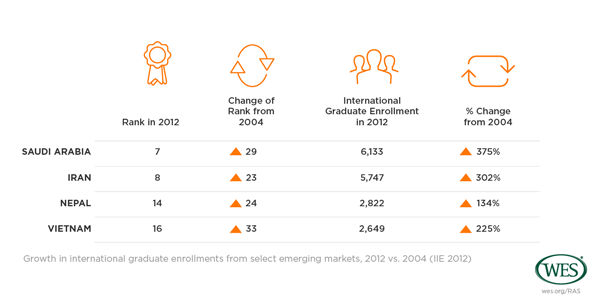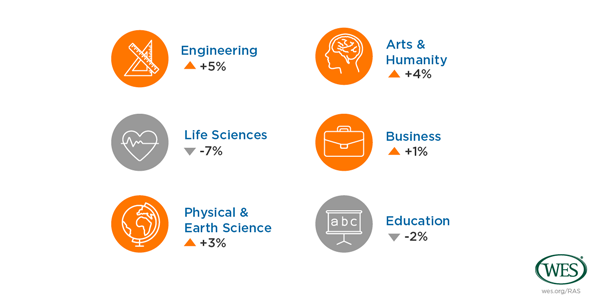Li Chang, Research & Advisory Services, WES
In the global competition for talent, graduate schools in the U.S. need to develop responsive strategies that diversify their student bodies and adapt to emerging recruitment trends.
International Students in the U.S By Level of Study, 1960-2012
For the first time since 2001-02, there are fewer international graduate students than undergraduate students enrolled in U.S. institutions of higher education (IIE 2012).
Overdependence on a Few Source Countries Raises Red Flags
56% of international students at the graduate level are from China, India, and South Korea (IIE 2012).
Graduate applications from international students remained flat from 2012 to 2013 due to a sharp decline in interest from China and South Korea. However, Indian applications jumped 22% after slow growth from 2009 to 2012.
Look Beyond Traditional Source Countries, Tap Into Emerging Markets
De-Risk Graduate Enrollment Beyond STEM Programs
176,120 international graduate students enrolled in science and engineering fields in 2010, as compared to
93,230 at the undergraduate level (NSF 2012).
The number of international graduate applications for the 2013-14 academic year in STEM fields has shown sluggish growth, indicating a need to promote other fields of study as a de-risking strategy.
Build A Responsive Recruitment Strategy
To achieve aggressive, diverse, and efficient international enrollment growth, we recommend a framework for responsive strategies that emphasizes the interplay of technology, partnership, and research.
Previous Issues of Mobility Monitor
- Globally Mobile Saudi Students: Agents of Economic, Social & Cultural Transformation? [7]
- How is the Mobility of Korean Students to the U.S. Shifting? [8]
- Mexico’s International Students: Down, But Not Out [9]
WES in the News
- Universities Seek Greater Enrollment From Abroad [10], China Daily
- New Libyan Scholarship Programme to Send 41,000 Students Abroad [11], ICEF Monitor,
- A World of Options [12], National Association of College and University Business Officers (NACUBO)
- Going to UK for Education? Higher Studies in Germany & France May be Cheaper & Easier [13], The Economic Times






